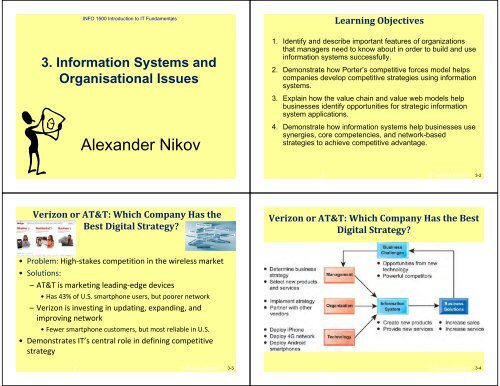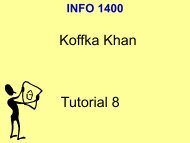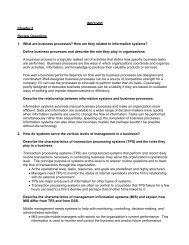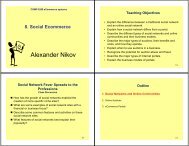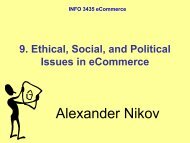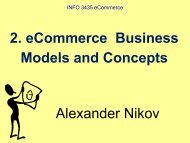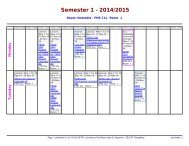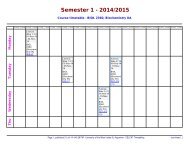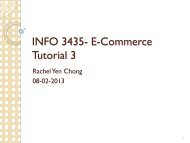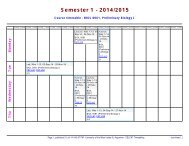Information systems and organisational issues
Information systems and organisational issues
Information systems and organisational issues
- No tags were found...
You also want an ePaper? Increase the reach of your titles
YUMPU automatically turns print PDFs into web optimized ePapers that Google loves.
INFO 1500 Introduction to IT FundamentalsLearning Objectives3. <strong>Information</strong> Systems <strong>and</strong>Organisational Issues1. Identify <strong>and</strong> describe important features of organizationsthat managers need to know about in order to build <strong>and</strong> useinformation <strong>systems</strong> successfully.2. Demonstrate how Porter’s competitive forces model helpscompanies develop competitive strategies using information<strong>systems</strong>.3. Explain how the value chain <strong>and</strong> value web models helpbusinesses identify opportunities for strategic informationsystem applications.Alex<strong>and</strong>er Nikov4. Demonstrate how information <strong>systems</strong> help businesses usesynergies, core competencies, <strong>and</strong> network-basedstrategies to achieve competitive advantage.2© Prentice Hall 20113-2Verizon or AT&T: Which Company Has theBest Digital Strategy?Verizon or AT&T: Which Company Has the BestDigital Strategy?• Problem: High‐stakes competition in the wireless market• Solutions:–AT&T is marketing leading‐edge devices•Has 43% of U.S. smartphone users, but poorer network–Verizon is investing in updating, exp<strong>and</strong>ing, <strong>and</strong>improving network• Fewer smartphone customers, but most reliable in U.S.•Demonstrates IT’s central role in defining competitivestrategy3 © Prentice Hall 2011 3-3 4© Prentice Hall 20113-4
Outline1. Organizations <strong>and</strong> <strong>Information</strong> Systems2. How <strong>Information</strong> Systems Impact Organizations <strong>and</strong>Business Firms3. Using <strong>Information</strong> Systems to Achieve CompetitiveAdvantageIT <strong>and</strong> organizations influence one another– Complex relationship influenced by organization’s• Structure• Business processes• Politics•Culture• Environment, <strong>and</strong>• Management decisions3-56© Prentice Hall 20113-6The Two-way Relationship BetweenOrganizations And <strong>Information</strong> TechnologyWhat is an organization?This complex twowayrelationship ismediated by manyfactors, not theleast of which arethe decisionsmade—or notmade—bymanagers. Otherfactors mediatingthe relationshipinclude theorganizationalculture, structure,politics, businessprocesses, <strong>and</strong>environment.FIGURE 3-1– Technical definition:•Stable, formal social structure that takes resourcesfrom environment <strong>and</strong> processes them to produceoutputs•A formal legal entity with internal rules <strong>and</strong>procedures, as well as a social structure– Behavioral definition:•A collection of rights, privileges, obligations, <strong>and</strong>responsibilities that is delicately balanced over a periodof time through conflict <strong>and</strong> conflict resolution7 © Prentice Hall 2011 3-78© Prentice Hall 20113-8
Technical Microeconomic Definitionof the OrganizationThe Behavioral View Of OrganizationsFIGURE 3-2In the microeconomic definition of organizations, capital <strong>and</strong> labor (the primaryproduction factors provided by the environment) are transformed by the firm throughthe production process into products <strong>and</strong> services (outputs to the environment). Theproducts <strong>and</strong> services are consumed by the environment, which supplies additionalcapital <strong>and</strong> labor as inputs in the feedback loop.9© Prentice Hall 20113-9FIGURE 3-3The behavioral view of organizations emphasizes grouprelationships, values, <strong>and</strong> structures.10© Prentice Hall 2011 3-10Features of organizationsRoutines <strong>and</strong> business processes•Use of hierarchical structure• Accountability, authority in system of impartial decisionmaking• Adherence to principle of efficiency•Routines <strong>and</strong> business processes• Organizational politics, culture, environments <strong>and</strong>structures• Routines (st<strong>and</strong>ard operating procedures)•Precise rules, procedures, <strong>and</strong> practices developedto cope with virtually all expected situations• Business processes: Collections of routines• Business firm: Collection of business processes11 © Prentice Hall 2011 3-1112 © Prentice Hall 2011 3-12
Routines, Business Processes, <strong>and</strong> FirmsOrganizational politicsAll organizations arecomposed of individualroutines <strong>and</strong> behaviors,a collection of whichmake up a businessprocess. A collection ofbusiness processesmake up the businessfirm. New informationsystem applicationsrequire that individualroutines <strong>and</strong> businessprocesses change toachieve high levels oforganizationalperformance.• Divergent viewpoints lead to politicalstruggle, competition, <strong>and</strong> conflict• Political resistance greatly hampersorganizational changeFIGURE 3-413 © Prentice Hall 2011 3-1314 © Prentice Hall 2011 3-14Organizational cultureOrganizational environments:• Encompasses set of assumptions that define goal<strong>and</strong> product•What products the organization should produce•How <strong>and</strong> where it should be produced•For whom the products should be produced•May be powerful unifying force as well as restrainton change• Organizations <strong>and</strong> environments have a reciprocalrelationship• Organizations are open to, <strong>and</strong> dependent on, thesocial <strong>and</strong> physical environment• Organizations can influence their environments• Environments generally change faster thanorganizations• <strong>Information</strong> <strong>systems</strong> can be an instrument ofenvironmental scanning, act as a lens15 © Prentice Hall 2011 3-1516 © Prentice Hall 2011 3-16
Environments <strong>and</strong> OrganizationsHave a Reciprocal RelationshipDisruptive technologies• Technology that brings about sweeping change to businesses,industries, markets• Examples: personal computers, word processing software, theInternet, the PageRank algorithm• First movers <strong>and</strong> fast followers– First movers – inventors of disruptive technologies–Fast followers –firms with the size <strong>and</strong> resources tocapitalize on that technologyFIGURE 3-5Environments shape what organizations can do, but organizations caninfluence their environments <strong>and</strong> decide to change environments altogether.<strong>Information</strong> technology plays a critical role in helping organizations perceiveenvironmental change <strong>and</strong> in helping organizations act on their environment.17 © Prentice Hall 2011 3-1718© Prentice Hall 2011 3-185 basic kinds of organizational structureOther organizational features– Entrepreneurial:•Small start‐up business– Machine bureaucracy:•Midsize manufacturing firm– Divisionalized bureaucracy:• Fortune 500 firms– Professional bureaucracy:•Law firms, school <strong>systems</strong>, hospitals– Adhocracy:• Consulting firms• Goals• Constituencies• Leadership styles• Tasks• Surrounding environments19 © Prentice Hall 2011 3-1920 © Prentice Hall 2011 3-20
Outline1. Organizations <strong>and</strong> <strong>Information</strong> Systems2. How <strong>Information</strong> Systems ImpactOrganizations <strong>and</strong> Business Firms3. Using <strong>Information</strong> Systems to Achieve CompetitiveAdvantageEconomic impacts•IT changes relative costs of capital <strong>and</strong> the costs ofinformation• <strong>Information</strong> <strong>systems</strong> technology is a factor ofproduction, like capital <strong>and</strong> labor•IT affects the cost <strong>and</strong> quality of information <strong>and</strong>changes economics of information– <strong>Information</strong> technology helps firms contract in sizebecause it can reduce transaction costs (the cost ofparticipating in markets)• Outsourcing3-2122 © Prentice Hall 2011 3-22Transaction cost theoryThe Transaction Cost Theory of the Impact of<strong>Information</strong> Technology on the Organization•Firms seek to economize on transaction costs (thecosts of participating in markets)–Vertical integration, hiring more employees, buyingsuppliers <strong>and</strong> distributors•IT lowers market transaction costs for a firm, makingit worthwhile for firms to transact with other firmsrather than grow the number of employeesFIGURE 3-623 © Prentice Hall 2011 3-23Firms traditionally grew in size to reduce market transaction costs. IT potentially reduces thefirms market transaction costs. This means firms can outsource work using the market,reduce their employee head count <strong>and</strong> still grow revenues, relying more on outsourcing firms<strong>and</strong> external contractors. 24 © Prentice Hall 2011 3-24
Agency theoryThe Agency Theory of the Impact of<strong>Information</strong> Technology on the Organization•Firm is nexus of contracts among self‐interestedparties requiring supervision•Firms experience agency costs (the cost of managing<strong>and</strong> supervising) which rise as firm grows•IT can reduce agency costs, making it possible forfirms to grow without adding to the costs ofsupervising, <strong>and</strong> without adding employees25 © Prentice Hall 2011 3-25FIGURE 3-7As firms grow in size <strong>and</strong> complexity, traditionally they experience risingagency costs. 26 © Prentice Hall 2011 3-26Organizational <strong>and</strong> behavioral impactsFlattening Organizations•IT flattens organizations– Decision making pushed to lower levels– Fewer managers needed (IT enables faster decisionmaking <strong>and</strong> increases span of control)• Postindustrial organizations– Organizations flatten because in postindustrialsocieties, authority increasingly relies on knowledge<strong>and</strong> competence rather than formal positions<strong>Information</strong> <strong>systems</strong>can reduce the numberof levels in anorganization byproviding managerswith information tosupervise largernumbers of workers<strong>and</strong> by giving lowerlevelemployees moredecision-makingauthority.FIGURE 3-827 © Prentice Hall 2011 3-2728 © Prentice Hall 2011 3-28
Organizational resistance to change• <strong>Information</strong> <strong>systems</strong> become bound up inorganizational politics because they influence access toa key resource – information• <strong>Information</strong> <strong>systems</strong> potentially change anorganization’s structure, culture, politics, <strong>and</strong> work• Most common reason for failure of large projects is dueto organizational <strong>and</strong> political resistance to changeOrganizational Resistance <strong>and</strong> the MutuallyAdjusting Relationship Between Technology <strong>and</strong> theOrganizationImplementinginformation <strong>systems</strong>has consequences fortask arrangements,structures, <strong>and</strong> people.According to thismodel, to implementchange, all fourcomponents must bechangedsimultaneously.29 © Prentice Hall 2011 3-29FIGURE 3-930 © Prentice Hall 2011 3-30The Internet <strong>and</strong> organizations•The Internet increases the accessibility, storage, <strong>and</strong>distribution of information <strong>and</strong> knowledge fororganizations•The Internet can greatly lower transaction <strong>and</strong>agency costs–Example: Large firm delivers internal manuals toemployees via a corporate Web site, savingmillions of dollars in distribution costsCentral organizational factors to considerwhen planning a new system• Environment• Structure– Hierarchy, specialization, routines, business processes•Culture <strong>and</strong> politics• Type of organization <strong>and</strong> style of leadership•Main interest groups affected by system; attitudes ofend users•Tasks, decisions, <strong>and</strong> business processes the systemwill assist31 © Prentice Hall 2011 3-3132 © Prentice Hall 2011 3-32
Outline1. Organizations <strong>and</strong> <strong>Information</strong> Systems2. How <strong>Information</strong> Systems Impact Organizations <strong>and</strong>Business Firms3. Using <strong>Information</strong> Systems to AchieveCompetitive AdvantageUsing <strong>Information</strong> Systems to AchieveCompetitive Advantage•Why do some firms become leaders in their industry?• Michael Porter’s competitive forces model–Provides general view of firm, its competitors, <strong>and</strong>environment–Five competitive forces shape fate of firm1. Traditional competitors2. New market entrants3. Substitute products <strong>and</strong> services4. Customers5. Suppliers3-3334 © Prentice Hall 2011 3-34Porter’s Competitive Forces ModelPorter’s Competitive Forces Model (cont.)FIGURE 3-10In Porter’s competitive forces model, the strategic position of the firm <strong>and</strong> itsstrategies are determined not only by competition with its traditional directcompetitors but also by four other forces in the industry’s environment: newmarket entrants, substitute products, customers, <strong>and</strong> suppliers.•Traditional competitors–All firms share market space with competitors whoare continuously devising new products, services,efficiencies, switching costs•New market entrants–Some industries have high barriers to entry, e.g.computer chip business–New companies have new equipment, youngerworkers, but little br<strong>and</strong> recognition35 © Prentice Hall 2011 3-3536 © Prentice Hall 2011 3-36
Porter’s Competitive Forces Model (cont.)• Substitute products <strong>and</strong> services– Substitutes customers might use if your pricesbecome too high, e.g. iTunes substitutes for CDs•Customers–Can customers easily switch to competitor’sproducts? Can they force businesses to compete onprice alone in transparent marketplace?• Suppliers–Market power of suppliers when firm cannot raiseprices as fast as suppliersFour generic strategies for dealing withcompetitive forces, enabled by using IT•Low‐cost leadership• Product differentiation•Focus on market niche• Strengthen customer <strong>and</strong> supplier intimacy37 © Prentice Hall 2011 3-3738 © Prentice Hall 2011 3-38Low‐cost leadership <strong>and</strong> productdifferentiation•Low‐cost leadership– Produce products <strong>and</strong> services at a lower price thancompetitors while enhancing quality <strong>and</strong> level of service–Examples: Wal‐Mart• Product differentiation– Enable new products or services, greatly changecustomer convenience <strong>and</strong> experience–Examples: Google, Nike, AppleFocus on market niche <strong>and</strong> strengthencustomer <strong>and</strong> supplier intimacy•Focus on market niche–Use information <strong>systems</strong> to enable a focused strategyon a single market niche; specialize–Example: Hilton Hotels• Strengthen customer <strong>and</strong> supplier intimacy–Use information <strong>systems</strong> to develop strong ties <strong>and</strong>loyalty with customers <strong>and</strong> suppliers; increaseswitching costs–Example: Netflix, Amazon39 © Prentice Hall 2011 3-3940 © Prentice Hall 2011 3-40
The Internet’s impact on competitiveadvantage• Transformation, destruction, threat to some industries–E.g. travel agency, printed encyclopedia, newspaper• Competitive forces still at work, but rivalry more intense•Universal st<strong>and</strong>ards allow new rivals, entrants to market•New opportunities for building br<strong>and</strong>s <strong>and</strong> loyalcustomer basesBusiness value chain model•Views firm as series of activities that add value toproducts or services• Highlights activities where competitive strategies canbest be applied– Primary activities vs. support activities•At each stage, determine how information <strong>systems</strong>can improve operational efficiency <strong>and</strong> improvecustomer <strong>and</strong> supplier intimacy• Utilize benchmarking, industry best practices41 © Prentice Hall 2011 3-4142 © Prentice Hall 2011 3-42The Value Chain ModelValue webThis figure providesexamples of<strong>systems</strong> for bothprimary <strong>and</strong> supportactivities of a firm<strong>and</strong> of its valuepartners that canadd a margin ofvalue to a firm’sproducts orservices.• Collection of independent firms using highlysynchronized IT to coordinate value chains toproduce product or service collectively• More customer driven, less linear operation thantraditional value chainFIGURE 3-1143 © Prentice Hall 2011 3-4344 © Prentice Hall 2011 3-44
The value web is anetworked system thatcan synchronize thevalue chains ofbusiness partnerswithin an industry torespond rapidly tochanges in supply <strong>and</strong>dem<strong>and</strong>.The Value Web<strong>Information</strong> <strong>systems</strong> can improve overallperformance of business units by promotingsynergies <strong>and</strong> core competencies• Synergies– When output of some units used as inputs toothers, or organizations pool markets <strong>and</strong>expertise–Example: merger of Bank of NY <strong>and</strong> JPMorganChase–Purchase of YouTube by GoogleFIGURE 3-1245 © Prentice Hall 2011 3-4546 © Prentice Hall 2011 3-46Core competenciesNetwork‐based strategies• Activity for which firm is world‐class leader• Relies on knowledge, experience, <strong>and</strong> sharing thisacross business units•Example: Procter & Gamble’s intranet <strong>and</strong>directory of subject matter experts•Take advantage of firm’s abilities to network witheach other• Include use of:– Network economics–Virtual company model– Business eco<strong>systems</strong>47 © Prentice Hall 2011 3-4748 © Prentice Hall 2011 3-48
Traditional <strong>and</strong> network economicsVirtual company strategy•Traditional economics: Law of diminishing returns–The more any given resource is applied to production, thelower the marginal gain in output, until a point is reachedwhere the additional inputs produce no additional outputs• Network economics:–Marginal cost of adding new participant almost zero, withmuch greater marginal gain–Value of community grows with size–Value of software grows as installed customer base grows•Virtual company uses networks to ally with othercompanies to create <strong>and</strong> distribute productswithout being limited by traditionalorganizational boundaries or physical locations•E.g. Li & Fung manages production, shipment ofgarments for major fashion companies,outsourcing all work to over 7,500 suppliers49 © Prentice Hall 2011 3-4950 © Prentice Hall 2011 3-50Business eco<strong>systems</strong>An Ecosystem Strategic Model• Industry sets of firms providing related services <strong>and</strong>products– Microsoft platform used by thous<strong>and</strong>s of firms–Wal‐Mart’s order entry <strong>and</strong> inventory management• Keystone firms: Dominate ecosystem <strong>and</strong> createplatform used by other firms•Niche firms: Rely on platform developed by keystonefirm• Individual firms can consider how IT will help thembecome profitable niche players in larger eco<strong>systems</strong>51 © Prentice Hall 2011 3-51FIGURE 3-13The digital firm era requires a more dynamic view of the boundaries amongindustries, firms, customers, <strong>and</strong> suppliers, with competition occurring amongindustry sets in a business ecosystem. In the ecosystem model, multiple industrieswork together to deliver value to the customer. IT plays an important role in enablinga dense network of interactions among the participating firms.52 © Prentice Hall 2011 3-52
Video case: Customer Relationship Managementfor San Francisco's City Government1. How did the DTIS CRM team change the business process fordealing with ab<strong>and</strong>oned vehicles in San Francisco? How did the oldbusiness process work, <strong>and</strong> what kinds of problems arose? Whywas it necessary to change the business process before developinga new CRM system?2. Why is a CRM particularly useful for the support of "interaction" jobs(described in the text chapter) as opposed to "transaction jobs?"3. How does this city-wide system help different agencies collaboratewith one another?4. How has the system installed by DTIS helped integrate informationamong city agencies? What difference would this make forcustomer service?5. Considering the types of information <strong>systems</strong> discussed in thelecture, what type of system is this? How would you characterizethis system?1. How did the DTIS CRM team change the business processfor dealing with ab<strong>and</strong>oned vehicles in San Francisco?How did the old business process work, <strong>and</strong> what kinds ofproblems arose? Why was it necessary to change thebusiness process before developing a new CRM system?• It created a single reporting database <strong>and</strong> a single call center totake calls (a 311 call center).• The old process worked by citizens calling in <strong>and</strong> leaving voicemessages or working with motor vehicle or police departmentalpersonnel. A voice contact system.• This resulted in multiple calls for the same incident; confusionabout what agency to call; poor manual record keeping processes.• It was impossible to install a CRM with a single call center <strong>and</strong>single customer <strong>and</strong> event database without changing the oldprocess.53© Prentice Hall 2011 3-5354 © Prentice Hall 2011 3-542. Why is a CRM particularly useful for the support of"interaction" jobs (described in the text chapter) asopposed to "transaction jobs?"• Interaction jobs are ones where the primary value added by thelabor is in the form of talking, presenting, listening, thinking, <strong>and</strong>then acting. These kinds of jobs require online <strong>and</strong> real‐timeaccess to information in order to add value <strong>and</strong> facilitateinteraction.3. How does this city-wide system help differentagencies collaborate with one another?• Collaboration. The system provides a single data base for storinginteractions with individuals, <strong>and</strong> it can be accessed by all cityagencies through an intranet portal. This allows agencies to worktogether on solving problems which span agencies.55 © Prentice Hall 2011 3-5556 © Prentice Hall 2011 3-56
4. How has the system installed by DTIS helped integrateinformation among city agencies? What difference wouldthis make for customer service?• Integration. The key to the effectiveness of CRM <strong>systems</strong> is a"single point of contact" philosophy.• This is directly opposite of the prevailing "silo" mentality whichpervades both business <strong>and</strong> government. For CRM, there is onedatabase, one record, <strong>and</strong> a single call facility where customerscan5. Considering the types of information <strong>systems</strong> discussedin the lecture, what type of system is this? How would youcharacterize this system?• This is an enterprise wide (in this case city government wide)system.• Citizens call in with requests for service to a central call center.This results in a "ticket" or record of the call being place in thedatabase. Other call reps, <strong>and</strong> employees at other departmentscan access this data base on a city Intranet.• You can think of this system as being able to support transactions(TPS), develop reports (MIS), aid in real‐time decision making(DSS), <strong>and</strong> also prepare high level activity reports for seniormanagers (ESS). So it's one enterprise system with tremendouscapabilities that actually replaces what in the past would havebeen a multitude of <strong>systems</strong>.57 © Prentice Hall 2011 3-5758 © Prentice Hall 2011 3-58


